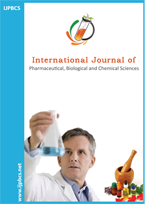DESIGN AND EVALUATION OF TRANSDERMAL PATCHES OF DULOXETINE HYDROCHLORIDE Development and Assessment of Transdermal Patches for Duloxetine Hydrochloride
Main Article Content
Abstract
Duloxetine hydrochloride is a selective serotonin and noradrenaline reuptake inhibitor (SSNRI) used for anxiety, diabetic neuropathy and fibromyalgia. The present investigation of this study was to develop the transdermal patches of duloxetine HCl as a once-day dosage form. The patches are prepared by solvent casting technique by using hydrophilic polymers HPMC E5 and HPMC E15 in different ratios. From the preformulation studies for drug excipient compatibility (DSC), it was observed that there was no interaction between polymers and drug. The developed patches were evaluated for weight variation, thickness, % of drug content, folding endurance, flatness, moisture absorption, moisture loss, and mechanical properties. The study results revealed that the obtained results were within the accepted limits. The in vitro release studies showed good release linearity along with acceptable flux for F3,& F4. The formulations F3, and F4 have shown Higuchi model drug release. In ex vivo studies permeation enhancer (d-limonene) is used, formulation (F4) containing HPMC E15 along with d-limonene as a chemical enhancer had shown extended ex-vivo drug release for 24hrs and shown maximum flux (125µg/sqcm/hr) with good release linearity when compared with control formulation and F4 formulation is optimized as it contains lower polymer content when compared to F3 formulation.
Downloads
Article Details

This work is licensed under a Creative Commons Attribution-NonCommercial-ShareAlike 4.0 International License.
How to Cite
References
Chien Yie W., Transdermal Therapeutic systems, Controlled Drug Delivery: Fundamentals & Applications. Robinson Joseph R, Lee Vincent HL. Eds, New York: Marcel Dekker 1987, 523.
B.S. Dave et al., Studies on effect of Limonene and other formulation ingredients on permeation of Diclofenac sodium through rat skin, International Journal of Pharmaceutical Excipients, 2(2), 2003, 50-54.
Jitendra Banweer et al., Formulation, Optimization and Evaluation of Matrix type Transdermal system of Lisinopril Dihydrate Using Permeation Enhancers, Drug Invention Today, 2(2), 2010, 134-137.
N. S Chandrashekar et al., Physicochemical and Pharmacokinetic parameters in drug selection and loading for Transdermal drug delivery, Indian Journal of Pharmaceutical Sciences, 70, 2008.
Mandal S. C et al., In vitro release and permeation kinetics of pentazocine from matrix-dispersion type transdermal drug delivery systems, Drug Development and Industrial Pharmacy 20(11), 1994, 1933-1941.
A. Bhattacharya et al., Effect of hydrophobic permeation enhancers on the release and skin permeation kinetics from matrix type transdermal drug delivery system of ketotifen fumarate, Acta Poloniac Pharmaceutica-Drug Research 58(2), 2001, 101-105.
Ramesh Panchagnula et al., Transdermal drug delivery of imipramine hydrochloride, Effect of terpenes, Journal of Controlled Release 79, 2002, 93–101.
B.S. Dave et al., Studies on effect of Limonene and other formulation ingredients on permeation of Diclofenac sodium through rat skin, International Journal of Pharmaceutical Excipients, 2003, 2(2), 50-54.
M. Aqil et al., In vivo Characterization of Monolithic Matrix Type Transdermal Drug Delivery Systems of Pinacidil Monohydrate: A Technical Note, AAPS Pharm SciTech, 2005,1-10.
Sadhana P. Guptha et al., Effective and controlled transdermal delivery of Metoprolol Tartrate, Indian Journal of Pharmaceutical Sciences, 2005, 67(3), 346-350.
Gattani S.G et al., Formulation and evaluation of Transdermal films of Ondansetron Hydrochloride, Indian Drugs, 2006, 43(3), 245-250.
Ramesh Gannu et al., Development of Nitrendipine Transdermal Patches: In vitro and Ex vivo Characterization, Current Drug Delivery, 2007, 4, 69-76.
Anil J Shinde et al., Development and characterization of transdermal therapeutic systems of tramadol hydrochloride, Asian Journal of Pharmaceutics, 2008, 265-269.
Mamatha T et al., Transdermal Drug Delivery System for Atomoxetine Hydrochloride – In vitro and Ex vivo Evaluation, Current Trends in Biotechnology and Pharmacy, 2009, 3(2), 15-23.
J. R. D. Gupta et al., Formulation and evaluation of matrix type transdermal patches of glibenclamide, International Journal of Pharmaceutical Sciences and Drug Research, 1(1), 2009, 46-50.
Aukunuru J et al., Development of granisetron transdermal films: In vitro and ex vivo characterization, Indian drugs, 47(5), 2010, 21-28.
Jitendra Banweer et al., Formulation, Optimization and Evaluation of Matrix type Transdermal system of Lisinopril Dihydrate Using Permeation Enhancers, Drug Invention Today 2(2), 2010, 134-137.
Pravin Gavali et al., Design and development of HPMC based polymeric film of enalapril, International Journal of PharmTech Research, 2(1), 2010, 274-282.
